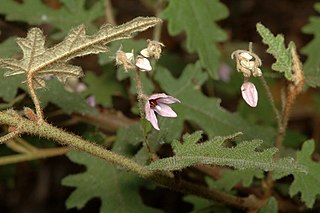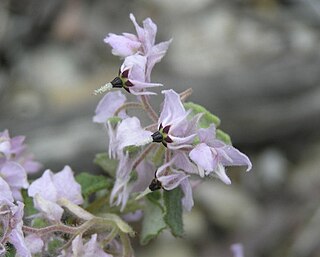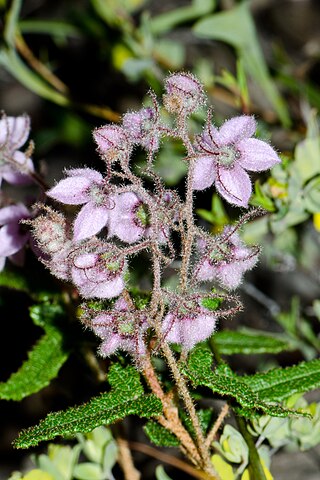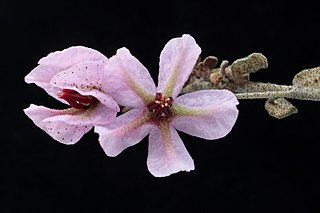
Lasiopetalum floribundum, commonly known as free flowering lasiopetalum, is a species of flowering plant in the family Malvaceae and is endemic to the south-west of Western Australia. It is an erect or spreading shrub with hairy young stems, egg-shaped leaves and pale pink, mauve or white flowers.
Lasiopetalum adenotrichum is a species of flowering plant in the family Malvaceae and is endemic to the Fitzgerald River National Park in the south of Western Australia. It is an erect shrub with hairy foliage, narrow egg-shaped to lance-shaped leaves and groups of white to cream-coloured and dark reddish-purple flowers.
Lasiopetalum angustifolium, commonly known as narrow leaved lasiopetalum, is a species of flowering plant in the family Malvaceae and is endemic to coastal areas of south-western Western Australia. It is a low spreading or dense, compact shrub with narrowly egg-shaped to narrowly elliptic leaves and compact groups of pink to purplish flowers.
Lasiopetalum cardiophyllum, is a species of flowering plant in the family Malvaceae and is endemic to the south-west of Western Australia. It is an erect shrub with egg-shaped to heart-shaped leaves and groups of pinkish flowers.
Lasiopetalum compactum, is a species of flowering plant in the family Malvaceae and is endemic to the south-west of Western Australia. It is an erect shrub with leathery, narrowly oblong leaves and cymes of white to pinkish flowers.

Lasiopetalum drummondii is a species of flowering plant in the family Malvaceae and is endemic to the south-west of Western Australia. It is an erect, slender shrub with many densely hairy stems, egg-shaped or oblong leaves and white, pink and red flowers.
Lasiopetalum lineare is a species of flowering plant in the family Malvaceae and is endemic to the south-west of Western Australia. It is an erect shrub with densely hairy young stems, linear leaves and bright pink and dark red flowers.
Lasiopetalum membranaceum is a species of flowering plant in the family Malvaceae and is endemic to near-coastal areas of south-western Western Australia. It is an erect, spreading shrub or subshrub with hairy young stems, egg-shaped leaves and mauve-pink and dark red flowers.
Lasiopetalum monticola is a species of flowering plant in the family Malvaceae and is endemic to the south-west of Western Australia. It is an erect, slender or straggling shrub with densely hairy branchlets, leaves and flowers, egg-shaped leaves and pink, cream-coloured or white flowers.

Lasiopetalum ogilvieanum is a species of flowering plant in the family Malvaceae and is endemic to the south-west of Western Australia. It is an open, spindly or rounded shrub with rusty-hairy young stems, narrowly egg-shaped to narrowly elliptic leaves and white or pink and dark red flowers.

Lasiopetalum oldfieldii is a species of flowering plant in the family Malvaceae and is endemic to the south-west of Western Australia. It is a low, spreading shrub with rusty-hairy young stems, egg-shaped to narrowly egg-shaped leaves and pink and dark red flowers.

Lasiopetalum oppositifolium is a species of flowering plant in the family Malvaceae and is endemic to the south-west of Western Australia. It is an open, erect shrub with rusty-hairy young stems, linear, narrowly elliptic or narrowly egg-shaped leaves and white, pink and dark red flowers.

Lasiopetalum pterocarpum, commonly known as wing-fruited lasiopetalum, is a species of flowering plant in the family Malvaceae and is endemic to a restricted area in the south-west of Western Australia. It is an open shrub with many densely hairy stems, egg-shaped and lobed leaves and pink and dark red flowers.

Lasiopetalum rotundifolium is a species of flowering plant in the family Malvaceae and is endemic to the south-west of Western Australia. It is an erect to spreading shrub with hairy young stems, round leaves with a heart-shaped base, and pink and dark red flowers.

Lasiopetalum trichanthera is a species of flowering plant in the family Malvaceae and is endemic to a restricted area in the south-west of Western Australia. It is an erect to straggling, sticky shrub with many hairy stems, egg-shaped leaves and bright pink and dark red flowers.

Lasiopetalum venustum is a species of flowering plant in the family Malvaceae and is endemic to a restricted area in the south-west of Western Australia. It is an erect shrub with hairy stems, egg-shaped, three-lobed leaves and pink and dark red flowers.
Thomasia × formosa is a species of flowering plant in the family Malvaceae and is endemic to a restricted area of the south-west of Western Australia. It is an erect, compact shrub with densely hairy branchlets, hairy, coarsely serrated, egg-shaped to elliptic or oblong leaves, and racemes of pink or purple flowers arranged in leaf axils.
Thomasia gardneri, commonly known as Mount Holland thomasia, is a species of flowering plant in the family Malvaceae and was endemic to a restricted area of Western Australia, but is now considered to be extinct. It was a low, erect shrub with scaly, narrowly egg-shaped leaves and racemes of pink flowers.

Thomasia microphylla is a species of flowering plant in the family Malvaceae and is endemic to the south-west of Western Australia. It is an erect, spreading shrub with egg-shaped leaves and racemes of pale pink or mauve flowers.
Thomasia tremandroides is a species of flowering plant in the family Malvaceae and is endemic to the south-west of Western Australia. It is an erect or low, spreading shrub with many stems, flimsy, papery, egg-shaped leaves and racemes of papery, mauve to pink flowers.










